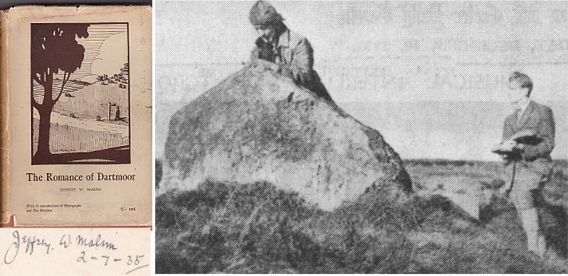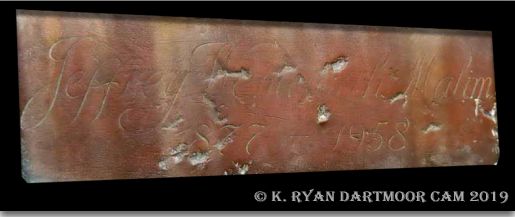
Over the years there have been numerous guide books written about Dartmoor and if asked to name a few the answers would probably be ‘Crossing’s Guide to Dartmoor’ Hemery’s ‘High Dartmoor’, Jeremy Butler’s ‘Dartmoor Atlases of Antiquities’, Worth’s ‘Dartmoor’, Rowe’s ‘Perambulation of Dartmoor’ and Mike Brown’s ‘Field guides’ to name but a few. But what about Jeffrey Malim’s book – ‘The Romance of Dartmoor? Until quite recently I had never come across his book although his name was familiar in the context of Ducks Pool and its letterbox. Then I managed to buy a first edition of this book which as a bonus he had signed. I think this book could best be described as the ‘unsung hero of guide’ books. Below is a review of the book which was written a few months after its publication:
“In his book one reads the mind of a man who not only loves the Moor, but never tires of exploring its beauties and mysteries. He takes us to the river sources, through their winding tracks, over the hill to the granite-topped tors, to the ancient monuments and circles. He reminds us of the elusiveness of Cranmere Pool – not so elusive in these days – and its remote situation in the heart of a morass at a high altitude.
But he offers a rather more elusive spot to search out – Ducks’ Pool – not placed on the ordnance Map, although it is more distinctive in size and situation than Cranmere. Ducks Pool, therefore, is hardly known to more than a few ardent wanderers on the Moor, and should be introduced as the southern centre of attraction by means of a post box and stamp placed in a cubby hole in the southern embankment.
His book tells the reader how to reach Ducks Pool just as it does all the other places of special interest. As a guide it should prove of great value. ‘The Romance of Dartmoor,’ by Jeffrey W. Malim (Jowitt & Son, Torquay, 6s).” – The Western Morning News, July 15th, 1935.
It soon becomes obvious from the book’s dedication that Malim was well acquainted with Dartmoor as amongst his three “staunch comrades,” who explored the moor with him was ‘Mooroaman‘ alias Fredrick Symes. This would clearly suggest that long days were spent trekking the wilds of the Moor and looking at the numerous old photos in the book soon confirms this theory. Dr. Jeffrey W. Malim lived in St. Marychurch at Torquay but when walking Dartmoor was more commonly known as ‘Moorover’. In his introduction Malim offers some insight as to how he became enthralled by Dartmoor’ “The first time I crossed Dartmoor was by motor car and I was not sorry to leave its desolation and dreary wastes behind; but some four years ago a friend introduced me to its fascinations and an abiding increased love for it came into being.” How true and I wonder how many other people could say the same thing, I know I can. He also gives some pointers of how at that time one should best begin their explorations; “It is better not to venture too far into the moor at first, until some familiarity with it has been gained, and no stranger should go without a strong walking stick, compass (luminous preferably) and an Ordnance map of 1 inch to 1 mile. Before going on a moorland expedition it is advisable, and a pleasurable thing, to read up the intended route, roughly mapping it out in a small note-book.” The book is dived up into nine main chapters which encompass; ‘General Impressions’, ‘Prehistoric Antiquities’, ‘Bridges’, ‘Crosses’, ‘Rivers and Brooks’, ‘Lakes, Pools and Ponds’, ‘Highways and Byways’, ‘the Forest and Woods’, and ‘Hills and Tors’. Within each chapter are suggested walks where the associated landscape features can be found along with explanations as to their existence. One that caught my eye and serves as a prime example of the book was; “The Pixey Lakes in Hound Tor Combe are situated in private property. They are charming little artificial pools made by damming the Becka Brook. The best place to see them is from above the steep hill-side by Grea Tor on Hay Tor down, and the best time is when mists are driving over the combe from the south-west, giving occasional glimpses of the fairy-like pools far below. The way to get to Grea Tor is by the old quarry track which leaves the main road north-east of Hay Tor Rocks, and pass in a northerly direction from the quarries, where there is a deep pool of water in which people bathe in summer. From the quarry it is a matter of continuing in the same north-westerly direction to reach the rocks above the combe.” I certainly had not heard of the place-name ‘Pixey Lakes’ before but although not named the modern OS maps do mark the spot as – ‘dams’. Secondly the route does show that he was not one for the ‘easy way’ because a much more gentler walk would be going there via Hound Tor.

The book and Ducks’ Pool letterbox.
There are two things that Jeffrey Malim was passionate about and both became interlinked; Ducks’ Pool and William Crossing. As can be gleaned from the review above he offered another alternative to what had become the ‘Mecca of Dartmoor’, (better known as Cranmere Pool) which was Ducks’ Pool. In the December of 1938 the Western Morning News announced that; “a postbox similar to the one at Cranmere has recently been placed at Duck’s Pool through the energies of “Moorover” (Dr. J. W. Malim of St. Marychurch), and that a bronze tablet is shortly to be fixed there in memory of William Crossing, the Dartmoor Explorer.” I think probably that the word “shortly” was a slightly optimistic word because it was not until 1938 that Malim with the help of the Dobson’s Moormen (of who he was a member) installed the plaque. In respect of William Crossing and Malim’s high regard for him he wrote: “Mentioning the late Wm. Crossing necessitates a few words about this outstanding Dartmoor man, for the very spirit of the moor is to be found in his writings.”
One amusing event occurred in 1939 which demonstrates his liking for Duck’s Pool and his walks with ‘Mooroaman’ who noted that; “On our way to Duck’s Pool between Sheepstor and Eylesbarrow while awaiting “Moorover,” a lizard found its way onto a sleeve of my overcoat, which was somewhat of a camouflaging colour, and seemed content to remain basking there in the sunshine, moving if a shadow passed across it. One could see its pulsations. The creature seemed reluctant to be dismissed into the bank on which we had been seated, whence it had emerged. Its markings were beautiful.” Finally, there are two memorial plaques on the side of the caprocks on Rowden Tor on Rowden Ball. One is inscribed “Jeffrey Wentworth Malim -1877 -1958” and the other “In Memory of Mary Malim – 1876 – 1953‘. One might wonder why with all of Dartmoor to choose from Rowden Tor was the place of choice. Apparently the family occasionally used to stay in the locality which would answer the question.

Sadly ‘The Romance of Dartmoor’ has been for ages out of print but occasionally you can track down a second-hand copy but be warned they don’t come cheap.
 Legendary Dartmoor The many aspects past and present of Dartmoor
Legendary Dartmoor The many aspects past and present of Dartmoor

I have two copies of this wonderful book by J.W Malin. I was brought up in St Marychurch and knew of the family as Doctors. Jowitts the publishers were in Fore St St marychurch and reading this book inspired me to walk on Dartmoor for the last 61 years. I am sort of retired and live in Denbury now ,so very close to Dartmoor which I enjoy so much ,even though there are changes that I fear might devalue it in the future. The book takes me back and in the late fifties was a magical experience ,which I still find today.IIt is nice to read your article and I agree with your thoughts about the book ,it was an inspiration for a book of poems I wrote in 2003/04 called Never Pass a Gate.I sold 4,600 copies and it shows people are still interested in the romance of Dartmoor.
Thanks for the info,I have your book and have posted a few of your poems on the Legendary Dartmoor Facebook group, they received many likes.
Hi Tim, You won’t know mw me from Adam but in December 1985, I was one of two people who created Dartmoor Magazine. In recent years, I have quietly collected interesting Dartmoor items. This include 100s of Edwardian glass plate negatives and a Dartmoor Manoeuvres Medals with a number of clasps. That aside, I was this afternoon researching Dr Malim’s war record. I did so because in 1991, I purchased Malim’s First World War medals – 1914 Star, British War Medal and Victory medal. Thanks, Kind Regards Laurie Manton.
Hi Laurie. I am currently researching Dr Malim for a talk and possible booklet for the Babbacombe & St Marychurch Local History Society. Information on his war record seems scanty due to the destruction of RAMC records in WW2, but I know he served in France, rising to the rank of Captain. Any further information would be much appreciated, especially if you were able to provide a photograph of his medals.